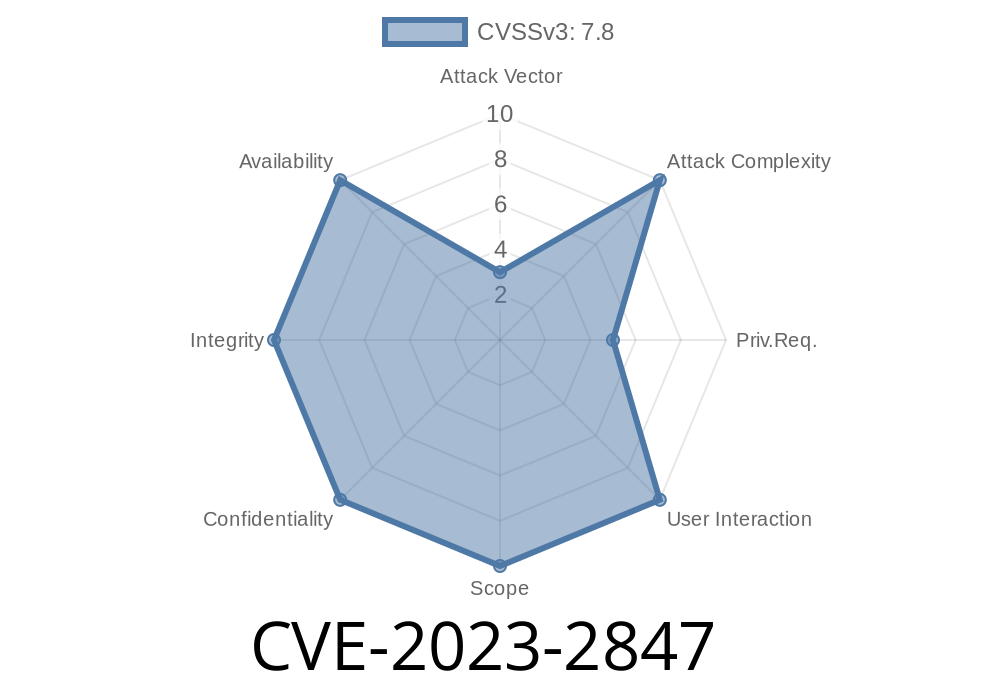In 2023, a critical vulnerability, identified as CVE-2023-2847, was discovered in several ESET security products. This bug allowed users with limited access (non-admins) to exploit a permissions error, escalating their privileges all the way to root or SYSTEM. This could let a regular user take full control of the affected system.
This post will break down how CVE-2023-2847 works, show a simplified exploit example, point to official references, and explain how ESET addressed this issue. We'll keep the language straightforward so both security researchers and IT admins can understand the risk and response.
What is CVE-2023-2847?
CVE-2023-2847 is a vulnerability in ESET’s endpoint security software for Windows and Linux. The problem lies in improper privilege management—in plain English, ESET’s service or one of its processes allowed regular users to trigger operations that were intended only for root/admin users.
In a secure system, only trusted users should be able to run things with the highest privileges. Due to the flaw, someone with minimal access could:
Official ESET Advisory
- https://support.eset.com/en/alert8128-potential-privilege-escalation-vulnerability-in-eset-products
Who is Affected?
Systems are at risk if ESET Endpoint Antivirus or ESET Endpoint Security products (Windows, Linux, select macOS) are installed in certain versions *before* the patches released in 2023.
If you're managing a network with ESET products, especially if multiple users log into shared computers, upgrading to the fixed versions is critical.
How the Vulnerability Works (Simplified)
The flaw involves a service or executable that accepts commands from lower-privileged users but executes them with SYSTEM or root permissions.
Here’s a simplified *example scenario* of how such bugs can exist
- The ESET service runs as SYSTEM/root.
- It exposes a command interface or kicks off processes/tasks.
- There is a misconfiguration in file or process permissions, or it fails to check who is asking for the action.
- A user with low rights (say, a regular Windows user or non-root Linux user) can exploit this to trick the service into running something they control.
Exploit Example (Demonstration Purpose Only)
Let’s say, for illustration, the vulnerable eset_service would load a configuration or DLL placed in a world-writable location. Attackers could overwrite it, then restart the ESET service, causing it to run their code as SYSTEM/root.
On Linux (generic privilege escalation pattern)
# Check if eset_service config or script is world-writable
ls -l /opt/eset/config/
# Suppose the config is world-writable:
# -rw-rw-rw- 1 root root 1234 Jan 1 12:34 eset.conf
# Attacker edits the file to include a malicious payload or command
echo '/bin/bash' >> /opt/eset/config/eset.conf
# Restart the service (if not protected)
sudo systemctl restart eset_service # or trick the system to restart it
# If not patched, the service might execute the payload as root
On Windows (illustrative pseudo-code)
:: Suppose the service executes a binary or script in C:\ProgramData\ESET\Temp\
:: If folder permissions are lax, a user could drop malicious.exe
copy malicious.exe "C:\ProgramData\ESET\Temp\malicious.exe"
:: Trigger ESET to load/run this file (e.g., by forcing an update or scanning operation)
> Note: Real exploits can be more complex and typically require local access. Security researchers often chain this with social engineering or malware to get code execution.
Mitigation
ESET has released new builds that remediate the bug by tightening privilege checks, restricting file and process permissions, and blocking unauthorized communication with privileged processes.
Update ESET Products Immediately
- Visit ESET’s official security advisory
Check for Unauthorized Users
- Review event logs for suspicious behavior, especially new administrator/root accounts or unexpected service restarts.
References & Further Reading
- CVE Details: CVE-2023-2847 at MITRE
- ESET Official Advisory: ESET Support Alert 8128
- RedTeam Security Advisory (external write-up): https://www.redteam-pentesting.de/en/advisories/rt-sa-2023-001
- General Guidance on LPE Vulnerabilities: OWASP Cheat Sheet: Privilege Escalation
Final Thoughts
CVE-2023-2847 is a textbook case of how improper privilege management in security software itself can lead to major breaches. If you run ESET products on your machines or across your network, patching right away is urgent. Even though the exploit requires local access, insiders or malware could leverage this to take over your systems.
Stay updated, audit your setups, and never underestimate local privilege escalation risks—especially in widely deployed security products.
If you found this post helpful, feel free to share it or comment below with your experiences or questions!
Timeline
Published on: 06/15/2023 08:15:00 UTC
Last modified on: 07/05/2023 13:28:00 UTC
